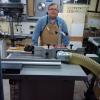I need to resaw a 2.5x6x70 piece of walnut into 3/4x6x70 doors. I have a bandsaw (Rikon 10-326) and a tablesaw (Sawstop contractor) to use. I have resawed up to 18 long pieces on the bandsaw, but a 70 piece gives me pause.
I figure I can do it on the table saw, cutting at max blade height, flip it long ways, and cut the other side by myself, or get the feed rollers out to do it on the bandsaw and have my wife help if needed.
Is one method better than the other if I can handle them both equally safely? Would one release the grain stress differently than the other or give a better product? I figure they will get jointed and planes either way to clean them up.
I cut a similar piece on the tablesaw this morning but I was making 3/4x3 stock, so I laid the 6 side flat on the table and cut to 3 width, the flipped it on edge and cut the 3/4 width. It worked well.




 Reply With Quote
Reply With Quote





